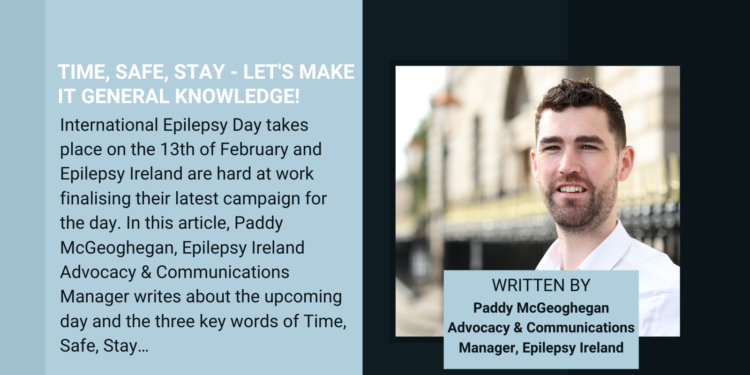International Epilepsy Day takes place on the 13th of February and Epilepsy Ireland are hard at work finalising their latest campaign for the day. In this article, Paddy McGeoghegan, Epilepsy Ireland Advocacy & Communications Manager writes about the upcoming day and the three key words of Time, Safe, Stay…

It was fantastic to once again be approached by the editorial team at Hospital Professional’s News to provide readers with an update on our plans for International Epilepsy Day 2023. As the name suggests, International Epilepsy Day is a global annual event that aims to spread awareness of a condition which affects over 50 million people worldwide.
With preliminary census data released towards the end of last year – coupled with existing prevalence data, we now estimate that there are over 45,000 people living with epilepsy across Ireland today, making it one of the most common neurological conditions in the country.
In our engagements with the public, this number often takes people by surprise. In market research conducted by Amarach Research on the behalf of Epilepsy Ireland towards the end of last year, 80% of over 1,000 respondents totally underestimated the prevalence of epilepsy, suggesting that the public believe epilepsy to be a quite rare condition.
So why is this perception out there? One reason perhaps is that despite the prevalence of epilepsy, there are still longstanding myths and misconceptions around the condition. There can be a misconception that people with epilepsy are not able to do certain things – such as perform in the workplace, drive, play sports or take part in social activities. Too frequently there is a belief that people living with epilepsy need to be treated differently due to their condition. In addition, due to the nature of seizures and how they present, there can be a social stigma attached to the condition for some people. These and other misconceptions can sometimes mean that a person might not necessarily widely disclose that they are living with the condition.
The reality is that, with almost 1 in 100 people living with epilepsy, epilepsy is far from rare and there are likely people within your close circle who are either living with the condition or somebody close to them is. This could even be your colleagues in a hospital setting – including nurses, doctors, and support staff.
What many people also don’t realise is that up to 70% of people living with epilepsy will go on to become seizure-free when the right treatment for their individual epilepsy is identified. For people within this 70%, epilepsy is sticking to their medication routine, knowing and avoiding their triggers, and thankfully for some, epilepsy can almost become an afterthought for them. For the other 30%, unfortunately the condition will be much more challenging due to uncontrolled seizures and the associated impacts of this.

International Epilepsy Day is a vital opportunity to improve understanding of epilepsy. At Epilepsy Ireland, we encourage people with epilepsy to share their stories of living with the condition as part of the day in order to break down the myths and misconceptions that exist around epilepsy. These lived experiences are an extremely powerful tool in helping people better understand what it is actually like to live with the condition and how to better support people with epilepsy.

Year on year, what is often reported to our service by people with epilepsy and their families is how crucial it is for everyone to know what to do in the event of a person having a seizure. In this regard, the message is very simple, consisting of just three key words – TIME, SAFE, STAY.
The message focuses on three positive ‘actions’ that should be followed, rather than on what not to do, while reducing the perception that seizure first aid is difficult and complex.
So, what do we mean by TIME, SAFE, STAY?
TIME
The first thing you should do is TIME the seizure. This is because if a seizure goes over 5 minutes, an ambulance should be called.
SAFE
Keep the person SAFE during the seizure. If a person is having a convulsive seizure, cushion their head with something soft if possible and remove any harmful objects, e.g., furniture from their vicinity. NEVER put anything in a person’s mouth or restrain them during a seizure. Be aware that there are also types of seizures where the person does not experience convulsions. Instead, they may “zone out” or stare blankly, become confused or agitated, display behaviours like chewing, smacking their lips, fiddling with their clothes, or wandering aimlessly. In these types of seizure, the person’s awareness of their surroundings is affected, and it is important to gently guide the person away from any danger. As with convulsive seizures, never restrict the person’s movements.
STAY
During the seizure and after it passes, STAY with the person. Often after a seizure, a person with epilepsy will be confused and, in many cases, exhausted. Make sure to stay with them until recovery is complete, explain what has happened and gently reassure them. The person may have experienced an injury if they have fallen, and if this is the case, ensure normal first aid steps are taken.
For last year’s International Epilepsy Day, in our continued promotion of these key words, we presented an eye-catching, tongue in cheek campaign – showing an exaggerated view of how people with epilepsy might be treated differently by the public due to their condition – and an exaggerated view of how seizures might be responded to incorrectly by the public. The campaign featured our incredible volunteers Wayne, Lucy and Lisa donning a suit of armour; being encased in a zorb ball; and wearing a suit of bubble wrap to help drive home the Time, Safe, Stay message.
With over 2.5 million impressions on social media, the campaign certainly grabbed the attention of the public, but equally we know that Time, Safe, Stay and seizure first aid is still some way off becoming general knowledge. This is why we return to the theme of Time, Safe, Stay this year – but with a new angle!
While the involvement of people with epilepsy will still be central to the efforts, this year we’re changing tact and making unsuspecting members of the public the subjects of our campaign as we aim to make Time, Safe, Stay general knowledge!
That is all we can reveal for now, but we’re really excited by what we’re working on and as hospital professionals, we hope you can help assist us in any way you can by sharing this important, potentially life-saving information amongst your colleagues, family and friends. Do join with us in the lead up to #EpilepsyDay to help increase awareness of this incredibly common condition and to help us make seizure first aid general knowledge amongst the public!
Further information on International Epilepsy Day and Seizure first aid –including videos and downloadable posters which can be used in your workplace – can be found on our website, www.epilepsy.ie.
l would also like to remind readers that Epilepsy Ireland is here to support people with epilepsy and their families on their respective journeys with the condition. Our network of Community Resource Officers cover the entire country and if you have a patient who may benefit from their support, please do not hesitate to get in touch with us.
Thank you reading this important piece about seizure first aid and Time, Safe, Stay and keep your eyes and ears peeled for our new campaign launching in the lead up and on International Epilepsy Day on February 13th!

View the February Magazine here








